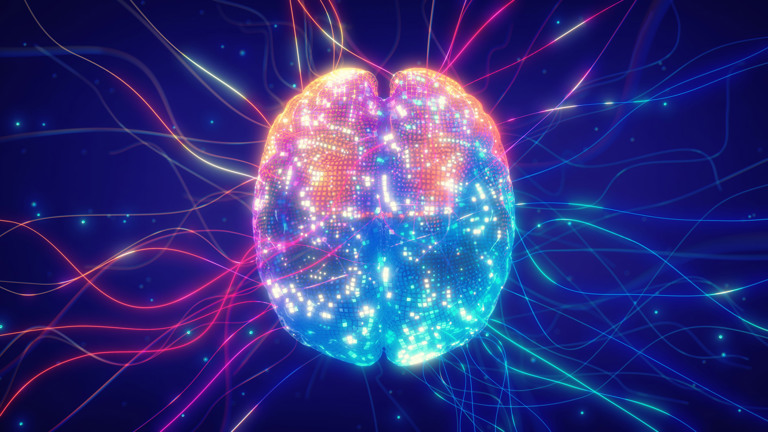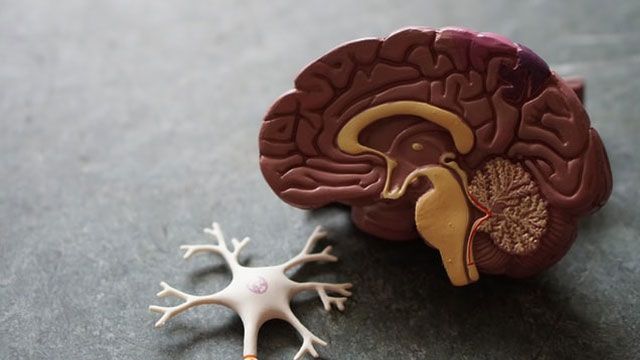Nature Knows and Psionic Success
God provides
Scientists Artificially Raise Mouse Heartbeats: What Study Means for Us

Anxiety can be created by the body, according to a recent study with mice that may have significant implications for humans.
The research, published in the journal Nature , demonstrated that artificially raising a mouse’s heart rate leads to anxious behavior in the rodent.
Scientists have long known that emotional states influence our bodily physiologically. But whether or not an increased heart rate might induce anxiety, or fear itself, has remained unclear.
“This paper addresses a long-standing question that has inspired us in the lab, dating back at least to [American philosopher and psychologist] William James,” Karl Deisseroth, an author of the Nature study at Stanford University , told Newsweek . “In 1884, James posited that bodily changes represent emotion, and that the brain’s perception and experience of these changes is the emotion, in a fundamental way.”
Newsweek Newsletter sign-up >
“As a psychiatry doctor in training 20 years ago, I was intrigued by epidemiology linking primary cardiac disorders with panic attacks,” he said. “But there was no way of proving a causal link arising from cardiac abnormalities, since there was no way of specifically and directly controlling cardiac function in real time in behaving animals.” An artist’s illustration of the human heart and brain. “This work reinforces the notion that autonomically controlled organs like the heart also transmit information about their state to the brain, which integrates this information with other sources to influence emotion,” one academic concluded. Previously, the available pharmacological and electrical interventions couldn’t be shown to have specific direct action on the heart muscle cells themselves.
“It took my lab’s development over 20 years of optogenetics—a way of controlling specific cells with light––and in particular a fast and non-invasive form of optogenetics that we developed over the past three years to enable these experiments,” said Deisseroth, who is affiliated with Stanford’s Department of Bioengineering, as well as the college’s Department of Psychiatry and Behavioral Sciences.
Newsweek subscription offers >
The researchers developed a non-invasive optogenetic pacemaker that enabled them to precisely control the cardiac rhythms of lab mice and make their hearts beat faster—up to 900 beats per minute. For context, a normal resting heart rate for a mouse usually hovers around 600 beats per minute.
“We found that directly pacing the heart at higher rates caused increases in anxiety-related symptoms, especially in potentially risky environments,” Deisseroth said. “This effect was mediated by communication from heart muscle-cell activity to the insular cortex in the brain.”
The Nature study demonstrates that cells outside the brain play an important role in setting emotional states.
“This could be a general principle, since many emotions are felt in the body—not just anxiety and fear and rage, but also positive emotions relating to reward and social bonding,” Deisseroth said.
The results of the study show that the insular cortex is the main area of the brain involved in the processes described, “concluding that both brain and body are mutually involved in the origins of emotional states,” Dr. Antonio Giordano, president of the Philadelphia-based Sbarro Health Research Organization, who was not involved in the Nature paper, told Newsweek .
The issue of the relationship between largely unconscious processes regulated by the autonomic nervous system—for example, the heartbeat, the gastrointestinal tract, etcetera—and emotions has been an area of debate going back to James’s theory.
Sometimes referred to as the James-Lange theory, this idea posited that emotional sensations are the sum of the autonomic sensations that an activity arouses, Clifford Saper, a professor of neurology and neuroscience at Harvard Medical School, who was also not involved in the Nature paper, told Newsweek .
“Under this theory when you see a bear, you are afraid,” Saper said. “But the feeling of fear is produced by the cerebral cortex seeing something threatening, setting off changes in heart rate, blood pressure, breathing, etcetera, in response to seeing a bear, and that the ‘feeling’ you get is the sum of the sensations produced by the autonomic response.”
“This paper studies the way that the brain reacts to a stressful stimulus, showing that the brain sensation of the changes in heart rate augment the emotional response—although may not be the sole cause of it. It is a well done study by a very strong group of scientists.”
Deisseroth said it is “quite likely” that the study’s findings could be applicable to humans as well, even though these animals are not perfect model.
“The same basic circuitry is present in both species, and human epidemiology—the source of my initial psychiatric inspiration—strongly correlates primary cardiac disorders and anxiety symptoms, including panic attacks,” Deisseroth said.
Vasanth Vedantham, a professor of medicine at the University of California , San Francisco, who was not involved in the Nature study, told Newsweek that the paper’s authors used “innovative” methods and that the main finding is generally “well-supported” by the data.
“The result itself is not necessarily surprising and fits with current thinking about the relevance of bodily states to determination of the state of arousal—what is important is that the methods used can be generalized and will allow for a deeper exploration of the mechanistic pathways in the heart and nervous system that are involved in this processing,” he said.
“Thus, this work creatively circumvents experimental obstacles in this field and will open a new path to developing a detailed understanding of how bodily states influence the mind and its emotional states.”
The study provides some experimental support for the notion that the relationship between emotional states and the body involves a two-way flow of information, according to Vedantham.
“We are familiar with the notion that information taken in via sensory organs—vision, hearing, touch, etcetera—is processed and interpreted in the brain to influence our emotional states. This work reinforces the notion that autonomically controlled organs like the heart also transmit information about their state to the brain, which integrates this information with other sources to influence emotion—so the brain combines ‘external perception’ with ‘internal perception,'” he said.
“Importantly, the brain also influences the function of these organs so there is the potential for feedback. Thus, when we try to understand the factors that influence […]
Ramadan fasting and health benefits

Numerous studies have discovered that fasting can help you live longer, control your weight, improve your mood and concentration, increase your energy level, and improve the quality of your sleep. Among the numerous benefits of Ramadan fasting, we have included a few below.
Reduces hypertension
A new study published in The American Journal of Medicine shows that short-term intermittent fasting can help reduce hypertension or high blood pressure. This study contributes to a growing body of research showing that intermittent fasting can help improve heart health and reduce the risk for hypertension and other cardiovascular diseases.
Increases brain function
Fasting has also been shown to have numerous brain benefits, such as higher levels of nerve growth factor (NGF). This protein helps regulate neurons’ growth, maintenance, proliferation, and survival. NGF is essential for neurons’ growth and normal function in both the peripheral and central nervous systems. Fasting also increases the expression of brain-derived neurotrophic factor (BDNF), a protein that supports the survival of existing brain cells and encourages the growth of new ones. Low levels of BDNF have been attributed to an increased risk for Alzheimer’s disease.
Improves body composition
Fasting has been known to improve body composition. This means it can reduce the percentage of body fat a person has while increasing their muscle mass and overall health.
Fasting reduces cancer risk
It’s true! Fasting can help you reduce your risk of cancer. But how? Cancer cells cannot process ketones produced by the liver from fat and fatty acids when in a fasted state. Simply put, fasting helps starve cancer cells and makes them more susceptible to the body’s immune system.
Stimulates autophagy
Fasting stimulates autophagy, which is the process by which cells and tissues recycle damaged components. It’s what allows your cells to renew themselves and survive without starving. Autophagy promotes longevity and helps prevent conditions associated with aging, including cancer, heart disease, and neurodegenerative disorders such as Parkinson’s disease and Alzheimer’s disease.
Lowers inflammation
Fasting lowers inflammation, which is a significant cause of aging. This is because fasting triggers changes in your gut microbiota. After fasting, the gut microbiome becomes richer in bacteria with anti-inflammatory properties.
In brief, fasting during Ramadan is highly recommended as it helps with many health-related issues and gives numerous people great positive benefits.
Study Confirms Physical Exercise Should Be First Choice For Mental Health Treatment

Authored by Jennifer Marguilis via The Epoch Times (emphasis ours),
In a funk? Do you: a) reach for a bag of potato chips, b) call a friend, c) pop an extra anti-depressant, or d) head for the gym to sweat out the sadness? For years, studies have shown that exercise is one of the best ways to treat a range of mental health issues. A new analysis of that whole body of research makes this clearer than ever.
This new study , which was conducted by a team of 13 Australian scientists, was published in February in the British Medical Journal’s British Journal of Sports Medicine.
As the researchers explored, pharmaceuticals are usually the first response to mental health issues worldwide, with lifestyle adjustments like exercise, sleep hygiene, and a healthy diet considered merely as complementary choices, at best.
Even when lifestyle changes are recommended, they are seldom prescribed to patients in treatment by medical doctors. A Vast Evidence Base
In order to synthesize the evidence on the positive and negative effects of physical activity on depression, anxiety, and psychological distress in adults, the Australian researchers performed an “umbrella overview,” a comprehensive analysis of all the work that has been done on the subject to date.
The idea behind an umbrella review of this type is to try to quantify the strength of the signal.
One scientific study provides some direct evidence that a treatment is useful; but when hundreds of studies confirm each other, taken together, these studies more strongly suggest that a treatment or intervention may be widely effective and applicable.
Since so much research has been done in the field of exercise and mental health , the Australian team sought to examine the totality of the evidence.
To that end, they looked at nearly a hundred reviews, comprising over a thousand studies done, on over 100,000 participants. In other words, they conducted a “systematic [review] of systematic reviews, synthesizing a vast evidence base.” Exercise Best Treatment for Depression
Mental health is often pushed to the fringe of health care, but half of all people experience some mental health distress at some point in their lives, and more than 10 percent of people worldwide are currently struggling with mental health.
Anxiety is the most common problem—and seems to be becoming more pronounced among children and younger adults —while depression poses the greatest burden to normal life function.
The Australian researchers discovered that exercise provided the best results when used for treating depression . More specifically, exercise was 150 percent more effective than pharmaceuticals or Cognitive-Behavioral Therapy (CBT).
It was also better than psychological consultation or “talk therapy.” In fact, exercise was shown to reduce depressive symptoms by 42 to 60 percent, whereas talk therapy and pharmaceuticals only reduced symptoms between 22 percent and 37 percent.
Exercise was shown to be the best treatment for both anxiety and depression, even though pharmaceuticals are the most commonly recommended treatment for both. Any Kind of Exercise Works
Every kind of exercise worked . The numerous studies looked at many types and schedules of exercise, and they all worked—doing any movement regularly (including dancing, walking, and yoga) was a big improvement over doing nothing.
Read more here… Viagra Sales Went Soft As Exclusivity Expired
Government report finds that fluoride lowers children’s IQ – bureaucrats quickly bury it

( Natural News ) The United States Centers for Disease Control and Prevention (CDC), the National Institutes of Health (NIH), and the Department of Health and Human Services (HHS) conspired in tandem to cover up the findings of a six-year, long-delayed review of fluoride’s toxicity conducted by the National Toxicology Program (NTP), it has been revealed.
It was Assistant Secretary for Health “Rachel” Levine, the infamous transgender “woman” that fake president Joe Biden appointed to head up the HHS, that intervened last June to stop the release of the May 2022 NTP review, known internally as a monograph.
The Fluoride Action Network (FAN) responded to Levine’s obstruction of the review by filing a lawsuit, which ultimately prompted the report’s release on March 15, 2023. The conventional media is ignoring the report, of course, but we certainly are not as it shows that there is no safe exposure – none – to toxic fluoride.
Confirming and strengthening the findings of two earlier drafts of the study that were published in 2019 and 2020, respectively, the new meta-analysis received unanimous support from external peer-reviewers who determined that both prenatal and early-life exposure to fluoride reduces IQ levels in children.
(Related: Remember back in 2012 when Harvard University tried to claim that fluoride only causes brain damage outside the United States ?) Why does “Rachel” Levine want to keep you and your family in the dark about fluoride’s toxicity?
As far as we know, there is only one other historical example of an NTP report being blocked like this indefinitely, and that one centered around bombshell data exposing the carcinogenicity of Johnson & Johnson’s (J&J) asbestos-contaminated talc baby powder.
Just like with that blocked study, Levine, in this case, wanted to stop the public from learning the ugly truth about fluoride, which is added to most municipal water supplies across the U.S. Most other countries, comparatively, do not add fluoride to their water supplies.
The meta-analysis determined that 52 out of the 55 studies looked at definitely linked fluoride exposure to reduced IQ. Of the 19 studies deemed as being of the highest quality, 18 of them came to the same conclusion.
“[R]esearch on other neurotoxicants has shown that subtle shifts in IQ at the population level can have a profound impact … a 5-point decrease in a population’s IQ would nearly double the number of people classified as intellectually disabled,” the NTP review states.
FAN announced that the court had been waiting for the NTP report since the summer of 2020, during which there were many distractions occurring such as the George Floyd psy-op and the Wuhan coronavirus (Covid-19) scamdemic .
At the time, the judge in the case put it on abeyance following the first two weeks of trial and expert testimony, expecting the monograph to be published not long after that. The report never came, though, despite undergoing two unprecedented peer reviews by the National Academies of Sciences, Engineering, and Medicine (NASEM).
Though a controversial topic for many years, the review’s authors concluded that fluoride is a “presumed developmental neurotoxicant,” with 27 out of the 29 highest-quality studies confirming that fluoride at levels commonly added to water supplies heavily damages the brains of children.
“We have no basis on which to state that our findings are not relevant to some children or pregnant people in the United States,” the NTP announced about the findings, making sure to abide by political correctness in calling them pregnant “people” as opposed to pregnant women .
Despite their best efforts to hide this ugly truth from the American public, the Biden regime ultimately failed to keep this study in the closet, thanks to the efforts of FAN in giving it a proper “coming out” celebration.
There is never a good reason to consume fluoride. Learn more at Fluoride.news .
Sources for this article include:
UndercoverDC.com
NaturalNews.com
Brain: How Does Exercising Boost Brain Function?
Exercising boosts our physical and mental health While various people workout for various reasons, many people maintain healthy to fend against significant medical issues. Cardiovascular disease, obesity, diabetes, and stroke are a some of these ailments. Others exercise primarily with the goal of losing weight.
Only a small percentage of people workout with the goal of enhancing brain function. However, exercising also enhances memory, mental health, and cognitive function, and it prevents the onset of several neurological diseases. Keep reading as we share how exercising boost our brain health. Here’s how exercising boosts our brain health:
1. Boosts neuroplasticity
The capacity of your brain and nervous system to alter their activity in response to internal or external stimuli is known as neuroplasticity. This has a significant impact on learning new abilities, pastimes, and languages. According to some studies, exercise can enhance specific signalling components that support neuroplasticity. 2. Improves memory
The hippocampus, a region of the brain associated with memory, learning, and growth, may be aided by aerobic exercise such as walking, jogging, or gardening. It may help delay the hippocampus’s shrinkage, which as you age might cause memory loss. According to certain research, regeneration is stronger if you enjoy what you’re doing. 3. May help prevent dementia
Alzheimer’s disease and other types of dementia are more likely to affect people who don’t exercise regularly. That’s in part because exercise helps avoid numerous conditions including obesity, diabetes, high blood pressure, and depression that have been related to dementia. Yet physical activity also has a direct impact. Actually, scientists can observe it. A healthier brain will have more white and grey brain matter and less damaged tissue. 4. Increases oxygen supply to the brain
During exercise, your heart starts to beat more quickly, which increases the amount of oxygen getting to your brain. Your brain’s blood vessels undergo some alterations as a result, which could lead to an improvement in executive function, which includes working memory, adaptable thinking, and self-control. 5. Reduces stress
You would not be surprised to learn that regular exercise is recommended as a highly effective stress reliever. You may have seen this yourself. Exercising helps redirect energy and can help improve quality of sleep and boost happy hormones. By lowering levels of stress-related chemicals like cortisol and adrenaline, exercise is known to lower stress. 6. Prevents brain fog
Those who suffer from any degree of cognitive impairment are said to be in "brain fog," also described to as blurring of consciousness. Poor attention, a lack of concentration, and memory problems are possible symptoms. But while exercise enhances memory and learning, it also activates several brain regions and allows the production of the neurotransmitters norepinephrine and BDNF, which boost alertness, attention, and vitality. 7. Boosts dopamine
Dopamine is another important neurotransmitter associated with exercise. Dopamine is crucial to how you experience pleasure. It also controls a number of other bodily functions, including the processing of pain, heart rate, sleep cycles, mood, motivation, and working memory.
Incorporate exercising to your daily routine not just for its benefits on your body but also your brain and mind.
Disclaimer: This content including advice provides generic information only. It is in no way a substitute for a qualified medical opinion. Always consult a specialist or your own doctor for more information. NDTV does not claim responsibility for this information.
Research suggests common dry cleaning chemical is linked to Parkinson’s disease

( Natural News ) A study has revealed that a common chemical used to dry clean clothes may be linked to increasing cases of Parkinson’s disease , the world’s fastest-growing brain disorder.
The study was published in the Journal of Parkinson’s Disease and was conducted by a group of scientists from Alabama, California, New York and the Netherlands.
The research builds upon decades of research that linked long-term exposure to TCE to Parkinson’s, a progressive disease that causes nerve cells or neurons in the basal ganglia to become damaged or die. This then reduces levels of dopamine, a brain chemical that has a crucial role in controlling body movement. What is trichloroethylene?
Trichloroethylene (TCE) is a “ volatile, colorless liquid organic chemical .” It doesn’t occur naturally and is created by chemical synthesis.
For the past 100 years, trichloroethylene (TCE) has been used to degrease metal. TCE is also used to dry clean clothes.
Despite being banned by the food and pharmaceutical industries since the 1970s, TCE is still being used in many states in household products. Some products that contain the chemical include: Aerosol cleaning products
Carpet cleaners
Cleaning wipes
Paint removers
Spot removers
Spray adhesives
Tool cleaners
You may be exposed to TCE by inhaling it in the air, drinking contaminated water, or eating foods that have been in contact with contaminated water.
The chemical was used extensively by the U.S. military to degrease equipment. Data has shown that contaminated soil and groundwater can be found near many current and former military bases in the country.
Upon examining existing research, researchers who conducted the study reported that TCE may be linked to Parkinson’s. TCE is a threat to workers and the public, warns experts
Dr. Ray Dorsey, the study’s lead author from the University of Rochester in New York, warned that TCE has threatened workers, polluted the air and contaminated drinking water for over a century.
He added that global use is “waxing, not waning.”
According to a 2013 global study, TCE increased the risk of Parkinson’s sixfold.
The research team warned that the toxic chemical may be fueling increasing numbers of cases of Parkinson’s disease worldwide.
According to data, at least one million people in the U.S. currently have Parkinson’s. Doctors diagnose 60,000 Americans with the condition annually.
Celebrities like Brian Grant, who played for 12 years in the NBA, developed Parkinson’s when he was 36.
Experts think Grant was likely exposed to TCE when he was three since his father, who was a Marine at the time, was stationed at Camp Lejeune. TCE contaminates the U.S. military base.
Amy Lindberg was also exposed there while serving as a young Navy captain. She was diagnosed with Parkinson’s 30 years later.
The study also discussed other people whose exposure was due to living close to a contaminated site or working with TCE.
The list included Johnny Isakson, the late U.S. senator who stepped down from office after his Parkinson’s diagnosis in 2015. Fifty years earlier, Isakson served in the Georgia Air National Guard, which is known to use TCE to degrease airplanes.
The U.S. alone is home to thousands of TCE-contaminated sites. Cleaning and containment must be accelerated, warned the scientists.The research team also called for more research to learn more about how TCE contributes to Parkinson’s and other diseases. (Related: Study: Consuming apples, oranges and strawberries can help people with Parkinson’s disease live longer .)They added that TCE levels in groundwater, drinking water , soil and outdoor and indoor air must be monitored closely and that this information must be shared with those who live and work near polluted sites. The researchers also lobbied for finally ending the use of these chemicals.Minnesota and New York are the only two states that have banned TCE. However, despite 2022 findings by the Environment Protection Agency (EPA) that the chemical is “an unreasonable risk to human health,” the federal government has yet to ban its use.Data from earlier studies suggest a lag time of up to 40 years between TCE exposure and the onset of Parkinson’s. Experts say this provides a “critical window of opportunity.”Across the globe, at least six million people have Parkinson’s, including 145,000 in the United Kingdom. Other celebrities with the health condition include Sir Billy Connolly, Neil Diamond and Michael J. Fox. Parkinson’s is the fastest-growing neurological disease in the world. Rates of deaths and disabilities due to the disease outpaces other conditions.People with Parkinson’s often experience rigid muscles that cause them to freeze. The condition also causes side effects like balance problems, tremors and slowed movements. Can you prevent Parkinson’s disease? The exact causes of Parkinson’s disease are unknown, and there is no known cure for this progressive disease.Fortunately, there are ways to help prevent its onset and slow the progression of the disease .The prevalence of Parkinson’s disease is about 0.3 percent of the population over 40. The disease affects 94 out of every 100,000 people.Several factors also raise the risk of developing Parkinson’s: Older age Older age is a major risk factor for Parkinson’s. The disease is very rare for those younger than 50, but the chances of developing the condition get progressively higher if you’re 60 or much older. Sex According to data, men are 1.4 times more likely to have the condition than women.The exact reason is still being researched, but some experts think that estrogen, the female sex hormone, may be a protective factor. Environmental exposure Constant exposure to certain environmental contaminants like TCE and various substances may put you at a higher risk of developing the disease.This includes: Airborne copper, manganese, or lead Nitrogen dioxide in the air Pesticides Reduced exposure to sunlight Comorbid conditions A history of certain medical conditions earlier in life has also been associated with the development of Parkinson’s disease.These conditions include diabetes mellitus , obesity, traumatic brain injury (TBI) and cancer . Genetics There is also a significant genetic component to Parkinson’s. Some types of Parkinson’s are directly inherited and can be passed from a parent to their offspring. Reducing Parkinson’s risk Parkinson’s disease is hard to […]
How to remain calm in stressful situations

( Natural News ) Prepping can sometimes be stressful, but you need to be calm when disaster strikes, especially if you are the leader of your family or survival group.
When facing a disaster, how you react may decide the outcome. Staying calm ensures that you can make the right decision in time-sensitive scenarios.
Below are some strategies that can help you stay calm in high-pressure situations after SHTF. (h/t to Survivopedia.com ) Avoid alcohol and drugs
High-pressure situations aren’t always straightforward. Even if only one thing goes wrong, it can derail the rest of your emergency preparedness plans.
When this happens, you need as much control as possible.
But this can be tricky if you are drunk or on drugs, so it’s best to limit your intake of alcohol or drugs. If possible, avoid these substances completely.
If you are sober and clear-headed when SHTF, you can quickly make decisions for yourself or your family.
According to studies, smoking can increase anxiety even though some people use it to relieve stress. Experts think this is because nicotine is a stimulant, and anxiety is a common side effect of smoking.
You should also avoid stimulants like caffeine during stressful situations. High-caffeine beverages like coffee or energy drinks can make you feel more stressed and increase your blood pressure.
Stimulants like caffeine and depressants like alcohol will negatively affect your performance in high-pressure situations like a natural disaster.
Research shows that alcohol increases your body’s cortisol secretion over time. Short-term effects of this include impairing your body’s ability to think critically and make the best decisions in stressful situations. Breathing exercises
If you are looking for a simple way to stay calm when you are stressed, try breathing exercises. These exercises can help your body feel calmer.
There are psychological and physiological reasons behind this strategy. Breathing increases the flow of oxygen to your brain.
While this process happens daily, it can be crucial when you are facing stressful situations. When you breathe, you stimulate the parasympathetic nervous system (PNS).
The PNS works to relieve your body when you are stressed. It’s also a critical part of digestion and other bodily processes.
If you are stressed and overwhelmed, try breathing exercises . Deep breaths are particularly helpful when trying to reduce stress.
First, find a quiet place without any distractions. Inhale through your nose for five seconds, then exhale from your mouth for five seconds.
Repeat the exercise 10 times until you feel calmer. Doing breathing exercises for several minutes can significantly impact your stress levels. Eat stress-reducing foods
People deal with stress in different ways. Unfortunately, some people binge eat when they are stressed.
Instead of reaching for candy or a bag of potato chips, eat healthy foods that can help reduce stress.
Eating the right kinds of food can help lower your stress levels and keep your mind focused.
To reduce stress, focus on the hormone cortisol. It is directly responsible for your stress levels and cortisone can affect factors like your blood pressure, sleep, inflammation and other health factors.
While cortisol is good for your body, you need to maintain a balance to avoid adverse effects. Too much cortisol can result in high stress and other health problems.
This is where superfoods come in.
Foods that can assist your cortisone levels include: Vitamin B-rich foods like beef, chicken , eggs, fortified cereal, nutritional yeast and organ meats can help fight cortisol levels and improve metabolism
Foods high in unsaturated fats like avocados, chia seeds, salmon and walnuts can help reduce inflammation and regulate your cortisol levels. Foods rich in magnesium like avocados, bananas , broccoli, dark chocolate, pumpkin seeds and spinach can also help when you are stressed. Get enough sleep High-pressure situations can consume your thoughts and while you can prepare before SHTF, you should ensure your overall health by getting enough sleep .Sleep quality at night significantly affects how you function the next day. It can be hard to maintain a regular sleep schedule during a survival scenario, but you need to get enough rest so your body and mind can recover.As you sleep throughout the night, your body refuels itself so you are ready for the next day. Not getting enough sleep can raise your cortisol levels.If you have trouble sleeping, talk to your doctor about natural remedies like melatonin or herbal remedies. Read inspirational quotes Reading may be the last thing on your mind when SHTF, but seeing inspirational quotes can help set your mind at ease when things are stressful.Write down quotes from your favorite authors, or inspire yourself with quotes from great leaders like President Franklin D. Roosevelt. In his inauguration speech, Roosevelt said “The only thing we have to fear is fear itself.”If you are having doubts, take out your notebook and read your favorite quotes aloud. Reframe the situation Your mindset can change how you deal with your situation. If you are worried about being overwhelmed with stress, learn how to reframe the scenario.Don’t stress yourself by worrying about all the things that can go bad. Prepare for likely scenarios, then spin things positively so you can focus on helping others survive.If you are dealing with a nationwide power outage because of an attack on the energy grid, think of how prepared you are for a blackout.Use your skills to provide for your family and stay calm so you can assess the situation. Try stress-reducing activities If you are too stressed to function when SHTF, take a break and relax with some stress-reducing activities.Here are some activities that can help you relieve stress and remain calm: Chew gum – According to studies, chewing gum may reduce stress by lowering your salivary cortisol, which is the stress you can find in your saliva. Listen to music – Throughout the ages, people have used music to calm themselves and relax their minds. Play relaxing classical music, folk music, or your favorite music genre to calm yourself while facing a stressful situation. Listening to music triggers dopamine production in your body and positively affects your mood. It may also help improve […]
Diabetes and Toothlessness Together Worsen Cognitive Decline

Summary: A new study found that having both diabetes and complete tooth loss accelerates cognitive decline in older adults. The study emphasizes the importance of regular dental visits, adherence to diabetes treatment, and cognitive screenings for those with both conditions.
Source: NYU
Having both diabetes and tooth loss contributes to worse cognitive function and faster cognitive decline in older adults, according to a new study published in a special issue of the Journal of Dental Research focused on aging and oral health.
“Our findings underscore the importance of dental care and diabetes management for older adults in reducing the devastating personal and societal costs of Alzheimer’s disease and other related dementias,” said Bei Wu, vice dean for research at NYU Rory Meyers College of Nursing and co-director of the NYU Aging Incubator, as well as the study’s lead author.
Diabetes is a known risk factor for cognitive decline and dementia. Several of the hallmarks of diabetes—high blood sugar, insulin resistance, inflammation, and related heart disease—are thought to contribute to changes in the brain.
A growing body of research has revealed a similar connection among poor oral health, particularly gum disease and tooth loss, and cognitive impairment and dementia. Like diabetes, inflammation plays a key role gum disease, and these inflammatory processes may contribute to cognitive decline. In addition, painful gums and missing teeth can make it difficult to chew, leading to changes in diet that can result in nutritional deficiency.
Nutritional deficiency, which can also be worsened by impaired glucose tolerance and insulin sensitivity in diabetes, is another risk factor for cognitive impairment and dementia.
“Poor oral health, diabetes, and cognitive decline are all connected, and we’re beginning to understand how they may influence and exacerbate one another,” said Wu.
While both diabetes and missing teeth are risk factors for dementia, little research has focused on the effects of having both conditions in the course of cognitive decline. To address this gap, Wu and her colleagues turned to the University of Michigan’s Health and Retirement Study, analyzing 12 years of data (2006-2018) from the longitudinal study in order to observe cognitive changes over time.
The researchers included 9,948 older adults who were grouped by age (65 to 74, 75 to 84, and 85 and older) in their analysis. The Health and Retirement Study included measures of memory and cognitive function, assessed every two years, along with questions about tooth loss, diabetes, and other health and demographic factors. In this analysis, the researchers were particularly interested in older adults who had lost all of their teeth. While both diabetes and missing teeth are risk factors for dementia, little research has focused on the effects of having both conditions in the course of cognitive decline. Image is in the public domain They found that older adults aged 65 to 84 with both diabetes and complete tooth loss had worse cognitive function than their counterparts without either condition.
Over time, older adults aged 65 to 74 with diabetes alone experienced accelerated cognitive decline, and those aged 65 to 84 without any teeth also experienced accelerated cognitive decline, but older adults aged 65 to 74 with both diabetes and complete tooth loss had the fastest rate of cognitive decline.
The relationship among diabetes, tooth loss, and cognitive decline was inconclusive for adults 85 and older, which may be explained by this group having overall greater cognitive impairment, potentially being healthier (as unhealthy individuals may be less likely to survive into their late 80s), or perhaps having more experience managing their diabetes.
For older adults with both poor oral health and diabetes, the researchers stress the importance of regular dental visits, adherence to diabetes treatment and self-care to control blood sugar levels, and cognitive screenings in primary care settings.
“Access to dental care for older adults—especially those with diabetes—is critical, and health care providers should educate their patients about the connection between oral health and cognition,” said Wu.
Funding: Additional study authors include Chenxin Tan and Xiang Qi of NYU Meyers, Angela Kamer of NYU College of Dentistry, Mark Schwartz of NYU Grossman School of Medicine, Huabin Luo of East Carolina University, and Brenda Plassman, Frank Sloan, and Mackenzie Martinez of Duke University. The research was supported in part by the National Institutes of Health (R56AG067619, P30AG059304, and P50MD017356).
The summary was generated via ChatGPT AI technology About this cognition research news
Author: Rachel Harrison
Source: NYU
Contact: Rachel Harrison – NYU
Image: The image is in the public domain
Original Research: Open access.
“ Diabetes, Edentulism, and Cognitive Decline: A 12-Year Prospective Analysis ” by Bei Wu et al. Journal of Dental Research
Abstract
Diabetes, Edentulism, and Cognitive Decline: A 12-Year Prospective Analysis
Diabetes mellitus (DM) is a recognized risk factor for dementia, and increasing evidence shows that tooth loss is associated with cognitive impairment and dementia. However, the effect of the co-occurrence of DM and edentulism on cognitive decline is understudied.
This 12-y cohort study aimed to assess the effect of the co-occurrence of DM and edentulism on cognitive decline and examine whether the effect differs by age group.
Data were drawn from the 2006 to 2018 Health and Retirement Study. The study sample included 5,440 older adults aged 65 to 74 y, 3,300 aged 75 to 84 y, and 1,208 aged 85 y or older. Linear mixed-effect regression was employed to model the rates of cognitive decline stratified by age cohorts.
Compared with their counterparts with neither DM nor edentulism at baseline, older adults aged 65 to 74 y (β = −1.12; 95% confidence interval [CI], −1.56 to −0.65; P < 0.001) and those aged 75 to 84 y with both conditions (β = −1.35; 95% CI, −2.09 to −0.61; P < 0.001) had a worse cognitive function. For the rate of cognitive decline, compared to those with neither condition from the same age cohort, older adults aged 65 to 74 y with both conditions declined at a higher rate (β = −0.15; 95% CI, −0.20 to −0.10; P < 0.001).Having DM alone led to an accelerated [...]
First-ever complete map of a fly brain uncovers scary similarities to AI networks

If you purchase an independently reviewed product or service through a link on our website, BGR may receive an affiliate commission.
Scientists have done something immeasurably intriguing: they’ve managed to map the brain of a larval fruit fly completely. It’s a huge step forward for neuroscience, as it gives scientists a complete picture of the 3,016 neurons and 548,000 connections that fuel the fly’s brain.
What’s even more intriguing about this accomplishment is that the brain appears to share an amazing amount of similarities with AI neural networks. Networks like those have made it possible for AI to successfully imitate human evolution .
Today’s Top Deals DJI Mini 3 drone is down to its best price, but even cheaper options are on sale
Tile tracker sale includes Pro, Slim, and Mate with 3-year battery life
Apple Watch Series 8 is back down to the lowest price ever at Amazon
The map of the fly brain is not pictured in this article but can be seen in detail within the paper the researchers published in the journal Science . It was created over 12 years, with researchers mapping the various neurons and synapses running through the larval fly’s brain. This map, called a connectome in neuroscience, includes the fly’s brain lobes and its nerve cord.
For many, this map may be considered a massive shift in neuroscience. That’s because many neural structures and pathways are believed to be conserved as animals and insects evolve. So, as the larval fruit fly grows from a small, writhing maggot into a full-grown fruit fly, it’s believed that the map of the fly’s brain will remain similar. It’s also possible that this may be true for other insects, mice, and even humans.
But this accomplishment also goes beyond the realm of neuroscience, as some believe it could help inform the creation of futuristic AI neural networks, AI networks that are designed to mimic the more realistic brain ways of animals and insects. Before, we’ve only had rough ideas of where the different elements of an animal’s brain may be; with this complete map of a fly’s brain, though, we know exactly where everything is.
Think of it as going to a small town without knowing where anything is. But now that we have the map, we can easily find every little grocery store, boutique, and restaurant. This discovery, and the hard work these researchers have put in to map the fly’s brain completely, will push research in the field to new levels, and with it, we have a better understanding of how the larval fruit fly’s brain works as a whole.
Don’t Miss: Remarkable new enzyme can turn air into electricity
More Top Deals from BGR
For more stories like this, follow us on MSN by clicking the button at the top of this page.
New Understanding of Aging Processes in the Brain Unearths Target for Therapies

Scientists from the Trinity Biomedical Sciences Institute (TBSI) have shed new light on ageing processes in the brain. By linking the increased presence of specialised immune cells to conditions such as Alzheimer’s disease and traumatic brain injury for the first time, they have unearthed a possible new target for therapies aimed at treating age-related neurological diseases.
The research, which benefited from a collaboration with experts at the University of Maryland School of Medicine and focused on microglia in the brain and spinal cord, is published today in leading international journal, Science Advances.
Microglia are a unique type of immune cell whose job it is to support nerve cells, defend against invading microbes, clear debris and remove dying nerve cells by engulfing and eating them. Emerging research indicates that microglia can have different functional responses depending on molecular and biochemical changes occurring within these specialised cells. Want more breaking news?
Subscribe to Technology Networks ’ daily newsletter, delivering breaking science news straight to your inbox every day.
Subscribe for FREE
In fact, various subtypes of microglia can be distinguished based on a property called autofluorescence. This is the tendency of cells to emit light of one colour after they have absorbed light of another, and it occurs because specific substances inside the cells absorb light. The substances stored in specialised cellular compartments include fat molecules, cholesterol crystals, metals and other misfolded proteins.
David Loane, Assistant Professor of Neuroscience in Trinity’s School of Biochemistry and Immunology in TBSI is the lead author of the research. He said: “As the brain ages, these materials build up inside autofluorescent microglia, which increase their autofluorescence as a result. Unfortunately, this accumulation of cellular debris also makes it harder for the microglia to perform their essential garbage collection tasks in the brain and to prevent neurological injury and neurodegenerative disease.
“In this study we found – in aged animals – that these microglia adopt a unique, dysfunctional state, which has a number of problematic impacts. For example, there is an increase in cellular stress and damage, an accumulation of fats and iron, alterations to metabolic processes and an increase in production of molecules that over-egg the immune response.”
In addition, the scientists demonstrated that autofluorescent microglia and associated inflammation were more pronounced under pathological conditions, such as in genetic risk factor models of Alzheimer’s disease, and – promisingly – were reversed by drug-assisted microglial replacement in aged animals.
Prof Loane added: “Furthermore, environmental exposure to acute traumatic brain injury in animals accelerated the age of onset and tissue-wide distribution autofluorescent microglia by increasing oxidative stress damage in the brain of injured animals.
“As a result, increasing evidence now suggests that the accumulation of autofluorescent microglia contributes to diseases of ageing and neurodegeneration. If these sub-populations of microglia are highly inflammatory and damaging to the brain, then targeting them could be a new strategy for treating aging-related diseases.”
Reference: Ritzel RM, Li Y, Jiao Y, et al. Brain injury accelerates the onset of a reversible age-related microglial phenotype associated with inflammatory neurodegeneration. Sci Adv . 2023;9(10):eadd1101. doi: 10.1126/sciadv.add1101
This article has been republished from the following materials . Note: material may have been edited for length and content. For further information, please contact the cited source.
Advertisement
Neurology Professors Just Listed the 9 Worst Habits for the Human Brain

Especially following the worst phase of a pandemic, maybe you embrace the idea of aging with more open arms than many of us might have a few years ago. If you count every birthday as a blessing, there are simple choices you can make every day to age well .
60 Funniest Birthday Quotes Perfect for Cards
And just like you follow practices to help your skin or heart age healthfully, we’re starting to understand that we can support our brains to better preserve memory , attention, reasoning and problem solving—making it easier to find your keys, engage with loved ones, and enjoy life for longer. Says Joe Verghese, MBBS, MS, a professor of neurology and founding director of the Montefiore-Einstein Center for the Aging Brain in New York City: “A lot of research shows that healthy lifestyles and engaging in cognitively stimulating activities have a really robust effect on slowing the rate of cognitive decline and preventing dementia.”
On the other hand, some frequent habits can make you more vulnerable to memory and cognition problems down the road. Here’s what Verghese says are the worst habits that aren’t so beneficial for your brain, and what you can do to troubleshoot them right now.
Get The Healthy @ Reader’s Digest newsletter You don’t exercise
Not getting enough physical activity may hasten cognitive decline and generally age us beyond our years. Exercising may prevent some of this decline. One 2020 review in Preventive Medicine highlighted a study that found cognitive decline occurred at twice the rate among inactive adults aged 45 and older, compared with active adults. Other research has supported the premise, including a 2022 study that found physical activity benefits the hippocampus, a part of the brain critical to memory.
The research isn’t conclusive, but exercise helps overall, Verghese says.
Here’s How Much Exercise You Need to Keep Your Brain Sharp, a Recent Study Says What to do
“Even if you start in your 60s, you can reap pretty dramatic benefits doing something simple like walking,” says Art Kramer, PhD, founding director of the Center for Cognitive and Brain Health at Northeastern University in Boston.
Weight training may also help, says Denise C. Park, PhD, director of research for the Center for Vital Longevity and professor of brain and behavioral sciences at The University of Texas at Dallas
This Gentle Exercise Is Proven to Help Prevent Falls in Seniors You sit around all day
Americans are sitting around more than ever—often in front of a screen—according to one 2019 American Medical Association study . This non-activity may contribute to brain changes associated with worsened memory. What to do
Get up and walk around five minutes every hour. You can even set a timer to remind yourself. In a 2019 sports medicine study , aspects of cognitive function improved among participants who broke up periods of prolonged sitting. Similar benefits have been seen among schoolchildren—evidence that maybe a little recess time might not hurt for us grownups, too.
Here’s How Long You Need to Walk to Lower Your Blood Sugar, New Research Finds You eat fast food and drink sugary beverages
The exact diet that can damage your heart can also damage your brain, namely food and drink high in fat and sugar. According to a 2017 Alzheimer’s study , people who drank more than one sugary beverages each day had a smaller brain volume and scored less on memory tests, both of which can indicate potential Alzheimer’s disease in the future.
Research also tells us that a healthy diet may preserve brain function, including memory and processing speed. Diets tailored to individual characteristics, including cultural background, have shown particular promise in this area, research says.
Eating These Foods Can Lead to Premature Death, Says New Study What to do
The National Institutes of Health points to the Mediterranean diet as one that is also good for your brain. The diet puts a premium on vegetables, whole grains, fish and olive oil. The DASH diet (Dietary Approaches to Stop Hypertension) is another good choice, says Dr. Kaplan.
It’s also a good idea to moderate alcohol, with a 2022 study found that even two drinks a day versus one was associated with a noticeable shrinkage in brain volume—read Drinking This Much Alcohol a Week Can Negatively Affect Your Brain . You spend a lot of time alone
Loneliness has been associated with cognitive decline, while being engaged also helps you find purpose and meaning in life—which research has linked with maintaining cognitive health and a lower risk for dementia. What to do
Look for ways to meaningfully interact with others: a long conversation or a shared activity. Also, have your hearing checked. “Poor hearing is a risk factor for cognitive decline,” says Verghese. Hearing loss can lead to depression and social isolation, as well as reduced sensory input that can lead to less brain stimulation.
How Friends Relieve Stress and Help Us Cope You don’t watch your blood pressure
We mentioned already that many heart-healthy practices will also benefit your brain. Top of the list is maintaining a normal blood pressure, says Dr. Verghese.
Both high and low blood pressure (low is more common in your 80s and 90s) can compromise your cognitive functioning. “At the most basic level, it’s not getting enough blood to the brain,” he explains. “It hardens and narrows blood vessels. It might also cause changes in brain cells and neurotransmitters.”
What’s the Best Exercise for High Blood Pressure? What to do
Take steps to keep your blood pressure less than 120/80 mmHg, which is considered normal. You cheat on sleep Skimp on sleep, and you run the risk not only of fogginess the next day but also of declining mental function over the long-term. “If you’re very exhausted, you don’t have the same focus as you do when you sleep and exercise,” says Dr. Park. What to do Adults should get at least seven hours of sleep a night, […]
Erythritol: Bad for Brain and Body?

A recent study links erythritol, a popular sugar alternative, to higher risk of stroke and heart attack.
Several specifics of this study have caused some to challenge the widespread applicability of the results.
Generally, decreasing processed food and added sweeteners may be best for overall and brain health.
Polina Tankilevitch/Pexels For years, there’s been debate about “healthier” sugar alternatives. One of the more popular ones is erythritol, a zero-calorie sugar alcohol found in a number of sweetener brands. This week, a study published in Nature found a correlation between erythritol levels and an increased risk for heart attack and stroke. While many are advising consumers to cut back on erythritol based-sweeteners, some have challenged the implications and methods of this work.
Erythritol is a sugar alcohol naturally in fruits and vegetables. We can also make it in our bodies from glucose. Yet the levels found in erythritol-sweetened foods can be over 1000 times higher than what’s found naturally. These elevated levels of the molecule have been proposed to have the potential to increase platelet stickiness, leading to a higher risk for clotting events, including stroke.
It’s worth noting that unconventional sweeteners have been under fire for their brain-harming effects for years. In a study published in the journal Stroke in 2018, researchers found an association between the consumption of the sugar substitutes saccharin, acesulfame-K, and aspartame and an increased risk for dementia and stroke. Yet consumption of sugar alcohols (a group that includes both erythritol and xylitol) has previously been associated with positive effects on metabolic health. This is especially important in the context of research linking better metabolic health with better brain health. New research on erythritol
In the recent study, researchers looked at thousands of people from multiple locations and tracked them for several years. These people were by and large not a healthy population, with the majority experiencing at least one risk factor for metabolic syndrome. (For example, most people in the largest cohorts had existing coronary artery disease and hypertension.) Blood from these participants was measured for a wide range of molecules, including erythritol.
On looking at a range of metabolites, researchers found that people with elevated blood erythritol levels tended to be at higher risk for major adverse cardiovascular events (stroke and heart attack). They went on to test the correlation between eating erythritol and levels of erythritol in blood and found dramatically higher levels of this sugar alcohol after consumption of a drink containing 30 grams. Notably, this intervention was only performed on eight people.
article continues after advertisement
Some have seen this study as solid evidence that erythritol should be avoided at all costs. Others have focused attention on potential issues with the study, including the fact that the studied population was rather unhealthy, that the researchers did not control for people who might have higher erythritol levels as a result of poor baseline health (instead of due to diet ), and the size of the interventional group (only eight people). Takeaways
What are the takeaways from this study? Some feel these results are sufficient to recommend we decrease our consumption of added erythritol (which is found in Splenda, monk fruit, Stevia-sweetened products, and especially in keto-branded products). Others feel the results are still too preliminary to change our dietary choices and may not be as relevant for metabolically healthy people.
Independent of the specifics of this study, one of the most notable ideas represented by this type of research is simple: Highly processed food is worth avoiding when possible. As much as we want to have our cake and eat it too (i.e., eat sweets without the negative health impacts), it’s tough to argue that this is an optimal plan. Previous research reveals that no-calorie sweeteners may negatively impact the microbiome and may even promote weight gain. For a society that consumes over 50 pounds a year of added sugar, re-sensitizing ourselves to enjoying less sweet foods seems to be key. More specifically, avoiding excess added sugars (be they natural or otherwise) is the conservative bet for health.
Based on the current research, are there better options for sweet alternatives? At this time, there may be reason to elevate allulose, Stevia, and monk fruit as potentially “safer” sweeteners. But it’s highly likely that in the years to come, additional research may demonstrate what seems already evident: There will always be more to learn, and consuming very high levels of anything — even if it’s “natural” — may have unexpected effects.
Why Exercise Boosts Mood and Energy

The “runner’s high” is real, and comes from other types of exercise, too. Feeling sluggish, tired, and sleepy? Need more energy to tackle your to-do list? Skip snoozing your alarm or those few extra cups of java and head to the gym to break a sweat.
According to Neil Paulvin, DO , a regenerative medicine doctor with a private practice in New York City, the benefits of exercise for your energy level are twofold. Exercise boosts your body’s fitness and also your mood, both of which contribute to your overall health and well-being. The Physical Benefits of Exercise That Boost Energy
Exercise changes the body physically in ways that help you feel energetic, including:
Increases endorphin levels Endorphins are neurochemicals, or hormones, in the brain that are produced and stored in the brain’s hypothalamus and pituitary gland , Dr. Paulvin explains. Your body releases them when you exercise, particularly when you challenge yourself with moderate-intensity activity such as aerobic exercise , moderate-intensity exercise, and weight training. Research has shown that endorphins rise an hour after exercise. And this post-exercise endorphin release helps relieve pain, reduce stress, and boost your overall sense of well-being, Paulvin says. It’s the “runner’s high.”
Boosts heart health Exercise boosts cardiovascular health , which allows you to have greater endurance throughout the day. For overall cardiovascular health, the American Heart Association recommends at least 150 minutes (2.5 hours) of moderate-intensity aerobic activity (such as brisk walking, water aerobics, and tennis) a week.
Improves sleep Yes, regular exercise can help you sleep better and therefore feel more refreshed and energized throughout the day. A study published in the Journal of Sleep Research looked at people with insomnia who engaged in a minimum of 150 minutes of moderate-intensity physical activity spread over the course of a week. Researchers found that this amount of physical activity was associated not only with a significant reduction in the severity of insomnia symptoms, but elevated mood, too.
Sharpens focus Mentally, we feel more energized and ready to tackle the world after a good workout because endorphins have boosted our physical energy level. According to a study of healthy people aged 65 years old and older published in the September 2021 Clinical Practice & Epidemiology in Mental Health , three sessions per week of moderate physical activity over 12 weeks improved cognitive performance, including an improvement in memory. Another study of older adults published in Oxidative Medicine and Cellular Longevity showed that 24 weeks of moderate aerobic exercise improved cognitive function, including concentration. While some researchers have speculated that higher intensity workouts might not have the same positive effect, a study in Perceptual and Motor Skills found that a session of high-intensity training improved cognitive function with respect to attention and short-term memory tasks. Britany Williams X Everyday Health: 5-Minute Express Full Body Barre Class
The Psychological and Mental Health Benefits of Exercise That Boost Mood
When you’re more energized, that’s a mood lifter. But there are a few other mechanisms whereby moving your body with exercise can lead to psychological and mental health benefits, too.
“Exercise often improves alertness and cognitive function over the long term, which can improve one’s mood,” says Gail Saltz, MD , a psychiatrist and clinical associate professor of psychiatry at NewYork-Presbyterian Hospital and Weill Cornell Medicine.
She says breaking a sweat also helps decrease feelings of stress and anxiety, which shifts mood in a more positive direction. Exercise causes the release of dopamine and serotonin , both neurotransmitters that play a role in maintaining mood, Dr. Saltz says. It also slows the release of cortisol , the hormone that flows when we’re under chronic stress. These hormonal changes are good for our brain cells, promoting improved cognitive function and boosted mood.
A large body of research has consistently shown that regular exercise is associated with lower incidence of depression . According to a review published in the journal Neuropsychobiology , exercise is associated with the release of neurotransmitters and proteins called neurotrophic factors, which cause nerves to make new connections, possibly improving brain function and possibly playing a role in the reduction of depressive symptoms.
And heading to the park, the gym or taking a group workout class gets you out of the house and interacting with others, which can ease isolation. Loneliness is nothing to underestimate; feelings of social isolation can have many negative effects on our health and well-being .
A review of studies published in February 2020 in National Academies of Sciences, Engineering, and Medicine noted that social isolation has been associated with an increased risk of early mortality, dementia, incident coronary heart disease, and stroke. Which Workouts Boost Energy the Most?
Any exercise or physical activity that gets the heart rate up and the blood flowing and releases endorphins is going to raise your energy level. Good cardiovascular exercises will strengthen your heart and give you more stamina.
Saltz recommends any type of aerobic activity to boost your mood and energy. “The exercise you are participating in [ideally would] raise your heart rate significantly for a period of [at least] 30 minutes,” she says. “Doing this three to four times a week has a mild antidepressant effect.”
Studies back up exercise’s benefits for depression. Aerobic exercise, according to a review of studies published in the January 2019 issue of Depression and Anxiety , was found to be an effective antidepressant intervention in adult patients (ages 18 to 65) with a clinical diagnosis of major depression.
But lower-intensity exercise, such as yoga, has also shown potential benefits when it comes to mood. Research suggests yoga may help reduce depression and anxiety . A review of studies published in October 2019 in the Journal of Yoga, Physical Therapy and Rehabilitation confirmed that yoga may be a strong complementary approach to pharmacotherapy and psychotherapy treatment.
Physical activity, even if it’s not intense, routine exercise, was associated with lower levels of depression in a review published in Frontiers in Psychology .
And a study published in September 2018 in the journal the Lancet Psychiatry , which […]
Compounds in Lion’s mane mushroom found to improve memory by aiding nerve growth

( Natural News ) A study found that compounds in the edible lion’s mane mushroom ( Hericium erinaceus ) can boost brain health by aiding the growth of nerve cells .
Researchers from the University of Queensland (UQ) in Australia made this finding in a study published Jan. 20 in the Journal of Neurochemistry . They managed to isolate the compounds N-de phenylethyl isohericerin (NDPIH) and hericene A from H. erinaceus samples. Cultured nerve cells were administered with these two compounds.
The study authors found that the two compounds demonstrated “potent neurotrophic activity” by promoting the growth and branching of nerves. They also administered hericene A and crude H. erinaceus extract to mice, with promising results.
According to their findings, mice were given lion’s mane mushroom extract and the derived compound reported “significantly enhanced hippocampal memory.” The brain’s hippocampus plays key roles in short-term, long-term and spatial memory.
“Extracts from these so-called lion’s mane mushrooms have been used in traditional medicine in Asian countries for centuries, but we wanted to scientifically determine their potential effect on brain cells,” said corresponding study author Frederic Meunier of UQ’s Queensland Brain Institute.
“Pre-clinical testing found that lion’s mane mushroom had a significant impact on the growth of brain cells and improving memory. We found that the active compounds promote neuron projections, extending and connecting to other neurons.” (Related: Lion’s mane: a smart mushroom choice for memory, mood and clarity. )
Dr. Ramon Martinez-Marmol, the study’s lead author, said their discovery had applications that could treat and protect against Alzheimer’s disease and other neurodegenerative cognitive disorders.
“Our idea was to identify bioactive compounds from natural sources that could reach the brain and regulate the growth of neurons, resulting in improved memory formation,” he said. Add lion’s mane mushroom to your diet to support brain health
H. erinaceus is native to Europe, Asia and North America. In the latter region, these mushrooms love to grow on dead and decaying hardwood trees. Natural food stores and farmer’s markets sell this nutritious fungus. Home cultivation kits for these mushrooms are also available.
While lion’s mane mushrooms are sold in their natural form, they are often powdered and mixed with dietary supplements. For those preferring the natural form of H. erinaceus , it can be cooked in several ways, such as roasting and sauteing. It can even be steeped as tea.
An article by Marie Viljoen on MarthaStewart.com expounded on lion’s mane mushroom as a culinary ingredient . She described the mushroom as being “tender and spongy, with some bounce” and having “a very mild sweetness.”
Viljoen wrote that H. erinaceus works well as a substitute for crab or lobster. Lion’s mane mushrooms make an outstanding chowder, she added, owing to its quality as a sponge to soak up flavors of broths and soups it is added to.
However, she advised those wanting to use it as an ingredient for crab cakes to sweat the chopped mushrooms and draw out as much moisture as possible – lest the crab cakes will not hold together. She also advised against frying as it could amplify the bitter taste on the edges of some mushrooms.
“Lion’s mane should be well-cooked and not eaten raw. Like all raw mushrooms, they contain chitin in their cell walls, which can cause gastric upset or even an allergic reaction in high concentrations,” she wrote. The cooking process eventually decreases this chitin concentration, Viljoen continued.
Superfoods.news has more stories about lion’s mane mushrooms.
Watch this video about lion’s mane mushroom and its ability to protect against 5G radiation . 5G Protection | Lion’s Mane for Microwave Sickness/ EHS- and SO MUCH MORE!
This is a modal window.
No compatible source was found for this media.
This video is from the Non-Toxic Home channel on Brighteon.com . More related stories:
The 8 most powerful medicinal mushrooms known today.
Which mushrooms have the most brain-boosting benefits?
Lion’s mane lives up to its reputation as a great natural mood enhancer.
Enjoy a lion’s share of health benefits by adding Lion’s mane mushrooms to your diet.
5 Medicinal mushrooms you can grow in your home garden or forage in your backyard.
Sources include:
NaturalHealth365.com OnlineLibrary.Wiley.com EurekAlert.org MarthaStewart.com Brighteon.com
Long term abuse of NICOTINE or SUGAR drives depression, stress and anxiety through the roof – How will YOU overcome? (contributor content)

( Natural News ) (Contributor content) – Feeling anxious, depressed, or stressed? Most consumers have a major “crutch” they use to “get by” every day, throughout the day, that relieves them of these physical and mental conditions, but it’s only short-lived relief, and when the “juice” runs out, they have to “re-up” with more and more, driving the addiction deeper, with worsened symptoms, and making it harder to quit. Two of the most popular “crutches” and addictions in the world are sugar and nicotine. Others include alcohol, caffeine, prescription painkillers, and street drugs.
Nearly half of all Americans are overweight, and half of those folks are considered obese. Plus, one in every four Americans uses nicotine, whether by smoking, vaping, dipping, or chewing. After long term use and abuse of either or both, it is quite common for anxiety, depression, and stress to deepen their roots, and rear their ugly heads every time the sugar or nicotine “fix” wears off.
Do you feel like your physical and/or mental health is spiraling out of control? Depression can really make a person feel hopeless and defeated. Mental stress can quickly manifest into physical symptoms and even disease and disorder. Anxiety can lead to panic attacks and nervous system disorders. What to do? Let’s start this one off with sugar addiction. Humans are born hardwired to love sweet tasting foods because it’s a survival mechanism, so what’s the problem?
All humans are wired to like sweet tastes, as this protects us from eating toxic foods, so where did this all get so warped? How did sugar become a mental health problem, fueling depression and anxiety? Let’s take a look at sugar’s role in the brain to understand. Table sugar is highly processed from beets or sugar cane, with zero nutritional value, and acts like a drug, rather than a food.
They key is to watch out for white sugar, high fructose corn syrup (HFCS), and “added sugars” in all foods and beverages, as these contribute to chronic brain inflammation , which is a key underlying cause of… wait for it… psychiatric and neurodegenerative disorders, including depression and anxiety. Read the labels on everything you buy and avoid “added sugars” like the plague.
Sure, you pound some baked sweets or chug a Starbucks specialty frap, and you feel better temporarily, but then comes the crash, the withdrawal symptoms, and then depression. Serotonin and dopamine levels become a rollercoaster ride, with high ups and low downs (spikes then crashes), as neurotransmitters simply wait for the crutch. Energy and mood go right along for the ride, and when blood sugar crashes, anxiety can spike. Even long term use and abuse of “added sugars” can result in dementia , according to studies published by the National Institutes of Health. Nicotine dependence is scientifically correlated with depression, anxiety and stress
According to research published by NIH, “Smoking is linked to psychological symptoms and shows a moderate to high level of nicotine dependence …a correlation between nicotine dependence, on one hand, and depression and stress on the other.” Currently, more than 35 million people in America are addicted to smoking cigarettes, and 15 million are addicted to vaping, including teenagers and even some children (just ask middle school teachers).
Over time, nicotine use constricts blood vessels, limiting the delivery of oxygen and nutrients throughout the body. Of course, this drives all kinds of health problems, including, chronic fatigue, brain fog, sleeplessness, anxiety, depression , and of course, stress. Nobody plans for this when they start smoking or vaping, but it’s almost inevitable with continued use. The worst part is that Big Pharma and Big Tobacco are “in bed” together, always in cahoots, coming up with “nicotine alternatives” that just keep people addicted to the world’s third-most-addictive drug, including the patch, gum, lozenges, and inhalers. What to do about it? Remedy is defined as a substance of medical value derived from plants or natural sources and used as treatment for disease or disorder
A remedy is something that corrects or counteracts something, making a right from a wrong, or making up for a loss. A remedy is intended to cure you when you are ill. An herbal remedy is a “medication” (Big Pharma hates when natural health advocates use their word) prepared from plants, and this includes most traditional remedies for disease. What if there are natural remedies for ending addiction cravings , and doing so without withdrawals or that dreaded “crash?” Guess what? There are several, and they’ve been around for centuries, but most Americans just don’t know what to look for and where to look.
Many people are figuring out they can replace bad habits, like consuming too much sugar, nicotine, alcohol, or caffeine, by putting to work for them a new supplement beverage called Krave Kicker , that contains mucuna pruriens extract, a potent natural superfood, and vitamin B12 as methylcobalamin. The propriety blend is the ultimate boost for dopamine levels while helping to balance the central nervous system. It’s good to know there’s a natural remedy for everything under the sun, you just have to know what to look for and where.
Special Note: This article was authored by Herbal Remedy Insider, a researcher for Krave Kicker, the manufacturer of a functional beverage that contains a natural, herbal remedy for addiction cravings. This publisher was NOT compensated in any way for carrying this article. It is not a sponsored article, but the author is receiving publicity of this news item in exchange for providing the article at no cost.
Research for this article includes:
BeBrainFit.com
Healthline.com
NaturalNews.com
KraveKicker.com
NCBI.nlm.nih.gov
Pubmed.ncbi.nlm.nih
DrHealthBenefits.com
VeryWellMind.com
The #1 Brain Exercise for Memory Improvement, According to Neurologists

The #1 Brain Exercise for Memory Improvement, According to Neurologists “Hearst Magazines and Yahoo may earn commission or revenue on some items through these links.”
You likely already know to brush teeth to prevent dental cavities, work out to s trengthen muscles and wear sunscreen to protect skin, you may not realize there are things you can do to keep your brain sharp .
For starters, a 2019 study of nearly 200,000 adults found that those who had a healthier lifestyle were less likely to develop dementia over the course of eight years, even if they were genetically at risk for dementia — and a 2020 study came to a similar conclusion. Beyond general healthy habits, though, specific activities have been shown to boost brainpower and prevent cognitive decline: brain exercises. Do brain exercises work?
Probably — but it’s complicated. “Memory is not one thing, but it’s a combination of different things so when we talk about exercises or training for memory, I think it depends on what type of memory we’re referring to,” says Zaldy S. Tan, M.D., M.P.H. , the director of the Cedars-Sinai Health System Memory and Aging Program. Consider a trip to the grocery store: Remembering what you intended to buy without having a list to look at requires an ability to recall things. Remembering the layout of the store and where to find things requires more of a visual/spatial memory. Running into a peer from elementary school, remembering how you know them and holding a conversation requires a quick processing speed on top of recall.
Unfortunately, it can be difficult to study the effects that certain activities have on our brain. It’s not as simple as say, watching someone practice bicep curls every day and seeing their muscle girth increase over time. “The things that we’re engaged in on a day-to-day basis that are not specific to deliberately improving our memory — for example, reading a book, attending classes at a junior college because we’re interested, listening to NPR or something else that will expand your view of the world or watching documentaries — those are all great, but they haven’t been studied for us to conclusively say that if you do all of these things, you’re less likely to develop memory problems,” says Dr. Tan. “Speed of information processing can be enhanced by cognitive training by computer-based tests, for example, but it doesn’t necessarily mean that you’re going to be less likely to develop Alzheimer’s disease or other forms of dementia.”
That said, engaging in certain exercises (even if they’re specific to one type of memory skill) can’t hurt and may even help you in the long run. “Increasing these synaptic connections — increasing these areas of connections in the brain — that might help build reserve,” says , the director of Division of Cognitive Neurology. “If, in the future, you have unfortunate issues that affect the brain, such as strokes or dementia conditions, you’d have a little bit more reserved.”
It seems one of the best things you can do for better cognition is physical exercise. It increases blood flow to the brain; reduces the risk of stroke, high blood pressure and diabetes (three risk factors for developing memory problems); and lowers inflammation oxidation (which has also been implicated in dementia), according to Dr. Tan. In fact, a of nearly 1,300 women age 65 and older found that for every 31 minutes of moderate-to-vigorous physical activity a participant did every day, she had a 21% lower risk of developing dementia. Meanwhile, a concluded that people who regularly , running, swimming, bicycling, dancing, yoga, sports and exercise machines had a 17% lower risk of developing dementia than those who didn’t. New to exercise and not sure where to start? Check out our list of the to try at home or in a gym.
If you want to take the benefits of exercise to a whole new level, consider a sport that requires you to play with other people. On top of the physical exercise, shows that sports require you to make quick decisions and solve problems (Where is my teammate? Should I run faster? Which strategic play might work best right now?) and give you the opportunity to socialize with others, Dr. Scharre points out. “The whole brain is working really well, and it’s a great whole-brain activity,” he says.
The next time you open the calculator app on your phone, suggests you might want to pause for a second and decide if the math problem at hand is something you can solve without technology. In fact, found that senior citizens who given basic math and reading problems to work on every day for six months experienced boosts in processing speed and executive function.
Knowing two languages allows you to connect with others you may not have communicated with before, makes travel easier and supports a healthy brain. A 2020 found that people who are bilingual develop dementia at a later age than people who only speak one language. It may sound like a big commitment, but we found the to get you started — and some are totally free.
Doing a variety of puzzles is the key here since different ones engage different parts of your brain, but , and may be particularly helpful. “Sudoku is great for logic — that’s the frontal part of the brain. Crosswords increase your abilities to store vocabulary and think of words on your verbal side,” says Dr. Scharre. “ may be more of a visual/spatial thing.”
Performing music requires you to mix the physicality of touch with remembering and hearing — in a short amount of time. even found that people over age 60 who took piano lessons scored higher on tests of episodic memory and attention six months later than people who didn’t. Episodic memories are things we remember that happened in the past (whether it be 30 years ago or 30 days ago).
In , people with mild cognitive impairment or mild Alzheimer’s disease who did 30 minutes of guided meditations every day […]




